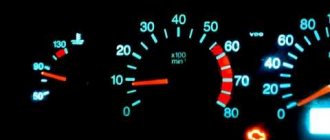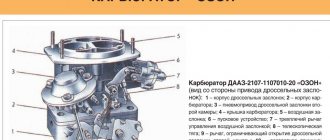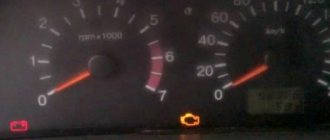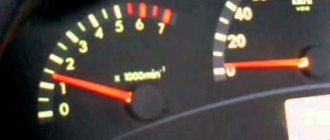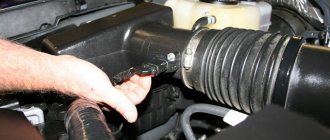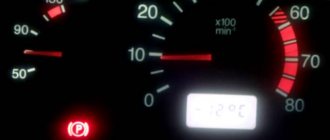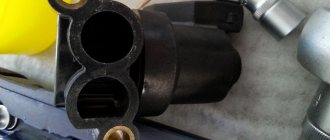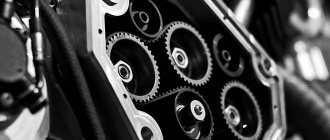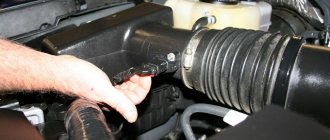Reasons why revolutions fluctuate
As mentioned above, there are quite a few reasons for floating engine speeds, and it will take a lot of time for a person who does not understand cars to find the reason. Below are all the possible reasons why a car engine begins to work unstably, and its speed begins to jump chaotically, so that the tachometer needle can drop to almost zero.
Air leak in the system
As you know, for an engine to operate, it requires not only fuel, but also air. These two substances mix with each other and form a fuel-air mixture. This mixture must be formulated within strict parameters for proper and stable operation of the engine; if any of the parameters are violated, the engine begins to run unstable.
Air enters the car engine through rubber and plastic tubes, which are joined with special fittings, clamps and pressed with bolts through special O-rings. All air supplied to the internal combustion engine is taken into account by special sensors that send a signal to the engine control unit; as soon as unaccounted air appears in the system, the fuel mixture is formed incorrectly, which leads to unstable engine operation.
Most often, air leaks occur in the following places:
- At the junctions of the inlet pipes;
- At the junction of the receiver and the cylinder head;
- In the sealing rings of fuel injectors;
- On the throttle assembly.
If the speed of your car begins to fluctuate, you need to check the engine for air leaks, and this can be done at a service station using a special smoke generator or by holding the inlet pipe with your hand, then the engine should stall and the pipes will shrink. If the engine does not stop, it means there is a strong air leak in the system.
Idle speed control
This part is responsible for supplying air in idle mode when the throttle valve is closed, that is, the gas pedal is not pressed. This sensor opens a special channel in the throttle valve through which air enters the system.
The sensor has many design flaws, namely, the principle of operation is based on a worm gear, which often becomes dirty and disables the sensor, thereby causing the engine to operate unstably.
The idle speed regulator is installed on the throttle valve of the car engine, through a special sealing ring, which also quite often dries out and begins to let air through, which leads to air leaks.
It should be noted that IAC affects engine operation only at idle speed.
Throttle position sensor
The TPS is installed on the throttle assembly and serves to determine the angle of rotation of the valve inside the throttle. Thanks to this part, the engine control unit understands how much the throttle has opened and how much air will flow into the engine. Such a sensor is made on the principle of a resistor, which changes its resistance as the bar moves. When the throttle opens, a slider moves along special tracks on the sensor.
The main reason for the failure of this part may be the rubbing of these tracks, which will lead to unstable operation of the internal combustion engine.
When the TPS fails, the engine speed begins to jump from 500 to 2500 rpm.
Throttle valve
The throttle is a part inside which has many mechanisms and channels through which air flows. Contamination of these channels can seriously affect the operation of the entire internal combustion engine. Quite often, engines with high mileage experience contamination of the throttle assembly, which leads to improper air supply to the engine. Because of this contamination, engine operation becomes unstable, and the speed begins to fluctuate.
This problem can be solved quite simply by washing the throttle with carburetor cleaner.
Mass air flow sensor
The air flow sensor (AFS) is used to count the air supplied to the engine. He does this through a special sensitive element that reads the amount of air. It happens that this particular element becomes dirty or becomes covered with plaque over a long period of time, which prevents it from determining the exact amount of air in the engine. Sometimes a problem with the mass air flow sensor can be solved by cleaning it, but this does not always help.
You can read more about how to check the mass air flow sensor here.
How to check the idle air control.
When you turn off the engine, the idle air valve completely closes the air passage through which the engine receives air while idling. Accordingly, when you turn on the ignition before starting the engine, the idle air valve opens the cross-section of the air channel in order for the engine to start. At the same time, a characteristic buzzing sound is heard in the throttle valve area. Since the idle air control is essentially an electric motor. If you turn the ignition on and off without starting the engine, the idle speed control will move back and forth. This manual is not suitable for torque idle speed controllers, they operate silently.
You can also check the idle speed sensor using the diagnostic program. Any diagnostic program has a parameter - “Management of actuators”. We go to the program menu and find the parameter, “Idling control”. With the engine running, through the diagnostic program we try to change the position or steps of the idle speed control, while the engine speed should change in one direction or another. If the IAC is controlled through the diagnostic program, the idle air controller is alive! And there is no need to replace it.
Carburetor engine
Floating speed on carburetor engines is most often observed due to problems in the carburetor, namely due to its blockage. For example, quite often the idle jet in the carburetor becomes clogged, which does not allow the engine to operate stably.
Fixing such a breakdown associated with the XX jet is quite simple; you just need to remove the air cleaner and blow out the system with a conventional pump.
Also, on carburetor engines, the speed quite often begins to float due to air leaks on the intake manifold, in the places where the carburetor connects to the manifold.
Basically, the reasons for floating speed on carburetor engines are quite small compared to injection internal combustion engines.
Malfunction of the ignition coils, as well as high-voltage wires and spark plugs.
Of course, when the engine does not idle smoothly, it sputters and stalls. The cause may be spark plugs, high-voltage wires, ignition coils. There may also be problems with the fuel injectors. But I won’t talk about these malfunctions, because I don’t see the point. This is the first thing people do as soon as they have problems with the engine in their car. The Internet is already full of information. I hope this article was useful to you. Write your comments below.
SUBSCRIBE TO NEW ARTICLES VIA VK GROUP!
Subscribe
This article is the property of Avto 1000.com Copying materials is prohibited!
If the cause is not identified
It is likely that you will not find the reason for the uneven operation of the engine; a modern engine is a complex device, and even experienced diagnosticians do not always immediately find the source of the breakdown. In such cases, we recommend contacting the professional technicians of our Technical Center50; the extensive experience of our workers allows us to quickly find the cause and eliminate the malfunction. Come to our car service center, Techcenter50 - we will quickly deal with the problems of your car, and we have low prices for repairs and diagnostics.
Unstable operation at medium and high speeds
It happens that the revolutions fluctuate while driving, that is, while the car is moving. At the same time, the car jerks and drives jerkily. Such movement is not only unpleasant, but also dangerous - there is a risk that someone will catch up and crash into you. There may be several reasons for such unstable operation:
- The air filter is clogged;
- Spark plugs are faulty;
- The lambda probe does not work;
- The catalyst is clogged;
- The exhaust valve in the engine has burnt out;
- The throttle position sensor has failed.
There may be other reasons; in complex cases, you cannot do without a good diagnostician.
Malfunctions of fuel supply systems
If the spark plugs are new or since the car was purchased it has not driven enough distance for them to wear out, then it is worth conducting a thorough visual inspection of the engine compartment in normal and working condition. When inspecting, you need to pay attention to the fuel pressure by connecting a pressure gauge to the fuel rail.
Problems with fuel supply are typical for injection engines, however, there is a possibility of problems occurring in other types of internal combustion engines. To check this version as the suspected cause of the problem, you should pay attention to the following details:
- Presence of contaminants on the fuel filter.
- Kinks in fuel supply pipes.
- Stuck fuel pressure regulator diaphragm.
- Nozzle not open enough.
Problems with injectors can also occur as a result of their contamination. It is caused by the use of low-quality fuel or prolonged use. Injector malfunctions can be identified by the manifestation of additional symptoms:
- Increased fuel consumption.
- Popping noises or explosions are heard when the car is moving.
- Exhaust combustion may occur.
- The car is difficult to start.
Air flow sensor
It is located between the throttle valve and the air filter. The sensor determines the volume of air passed through and sends information to the ECU. The latter adjusts fuel injection based on its data.
Mass air flow sensor
Inside the mass flow sensor there is a temperature compensation resistor, which often fails. Because of this, the sensor incorrectly determines the volume of oxygen, and accordingly, the control unit makes incorrect corrections. In some cases, you can get by with cleaning the sensor, but often it has to be replaced entirely.
Owners often fell for low-quality sensors. An original mass air flow sensor can cost 10 thousand rubles or more.
Therefore, there is a temptation to buy a cheaper analogue. But after installing it, the problem does not go away (or it goes away, but not for long). And only with a new original sensor the unit receives the correct information.
Popular brands:
Mercedes-Benz GL-Class
Common places for air leaks
- Loose clamps on pipes and vacuum hoses.
- Cracks in rubber hoses and pipes. Most often found near clamps, in places of contact with elements of attachments.
- Broken brake booster diaphragm.
- Leaking vacuum valves (PCV, EGR, absorber purge valve). The cause of the leak is a leaky membrane, but cracks in the housing should not be ruled out. If your car is equipped with HBO, check the vacuum corrector.
On Japanese-made cars, when troubleshooting, pay attention to the system of vacuum valves involved in adjusting the warm-up speed and opening the additional air channels.
- A crack in the plastic intake manifold due to a manufacturing defect or mechanical damage. Often such collectors consist of several elements assembled on sealing gaskets. If the gaskets become tanned due to temperature loads in the compressed state, air will be sucked into the intake manifold through them.
- Loose fit of the intake manifold to the cylinder head.
- Worn or incorrectly installed fuel injector O-rings.
- Wear of the throttle valve rotation axis in the housing (very common on Mitsubishi Lancer 9).
